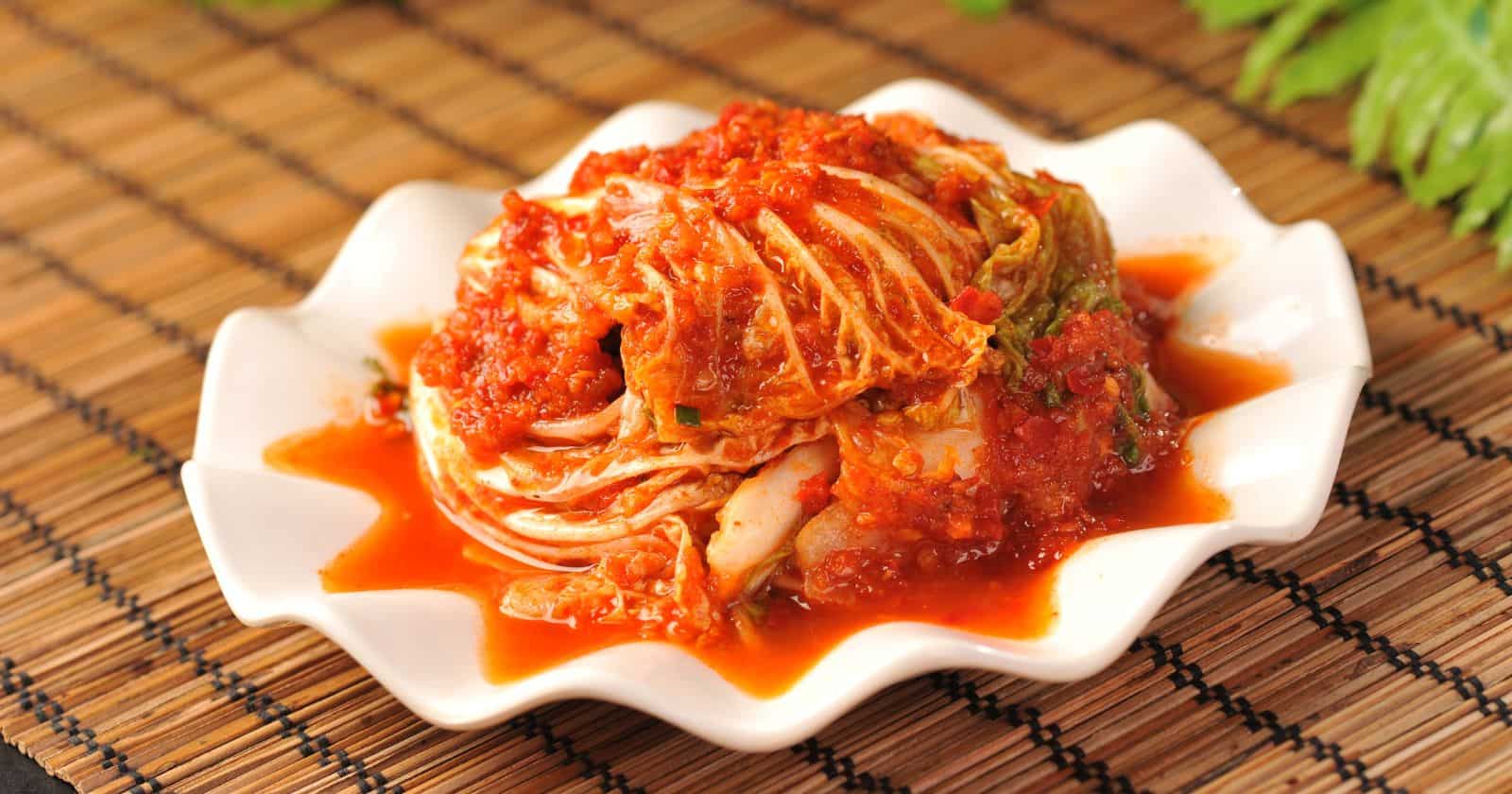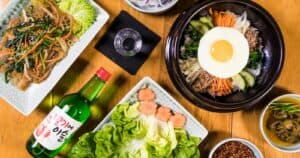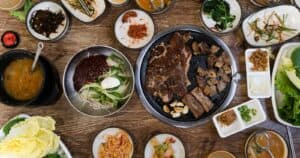When it comes to the strong smells associated with Korean food, it can all be traced back to the traditional fermentation methods used in Korean culinary arts. Fermentation involves the breakdown of sugars and starches in food by bacteria and yeast, resulting in the production of lactic acid and other compounds that give fermented foods their distinct flavors and aromas.
It’s this fermentation process that lends Korean dishes, such as kimchi and hongeo (fermented skate fish), their signature pungency. While these smells may seem intense to some, it’s important to remember that not all Korean dishes share the same olfactory characteristics.
In fact, Korean scientists are even working on reducing the strong smell of kimchi to make it more appealing to foreigners.
The Science Behind Fermentation: Uncovering the Process Behind Korean Food’s Unique Aromas
The fermentation process is what gives Korean food its unique aromas and flavors. Fermented ingredients like kimchi, fish sauce, and fermented soybean paste are commonly used in Korean cuisine and are responsible for the strong and pungent smells associated with Korean food. It all begins with beneficial bacteria that break down the sugars and starches in the food, creating lactic acid and other compounds that give the food its distinctive taste and aroma.
The duration of the fermentation process can vary greatly, ranging from a few days to several months. The specific dish and ingredients used determine the length of fermentation. It’s a slow and careful process that allows the flavors to develop and intensify over time.
However, the strong smells associated with Korean food can be off-putting to some foreigners. In an effort to make it more appealing to a wider audience, scientists in Korea are working on toning down these strong smells, such as the smell of kimchi. It’s a challenging task because the aroma is closely linked to the flavor of the food. Altering the smell too much could potentially change the taste and character of the dish.
Exploring the Role of Fermented Foods in Korean Culture: Tradition and Heritage
Fermented foods are a cornerstone of Korean culture, deeply rooted in tradition and heritage. They bring unique aromas and flavors to Korean cuisine, reflecting the country’s culinary identity. Kimchi, a globally renowned fermented vegetable dish, serves as a symbol of Korean pride and is celebrated for its health benefits.
As part of the fermentation process, beneficial bacteria break down sugars and starches in the food, producing lactic acid and other compounds. These compounds are responsible for the distinct taste and aroma of fermented foods. From doenjang (soybean paste) to ganjang (soy sauce), gochujang (hot pepper paste), and jeotgal (salted seafood), fermented foods are incorporated into a wide range of Korean dishes.
What makes Korean cuisine truly special is the combination of fermented foods with various seasonings like chile flakes, salt, sesame seeds, and garlic. This amalgamation creates complex and rich flavors, particularly evident in the popular Korean BBQ seasoning. The use of fermented ingredients has been an integral part of Korean culture for centuries, deeply ingrained in Asian food culture.
The fermentation process can vary in duration depending on the specific dish and ingredients used. It can range from a few days to several months, allowing time for the flavors to develop and intensify. Patience and skill are required to achieve the perfect balance of taste and texture.
Kimchi: The King of Korean Fermentation – Unveiling its Powerful Smell and Flavor
Kimchi, a traditional fermented vegetable dish from Korea, is renowned for its strong smell and flavor. This is due to its unique fermentation process, the presence of sulfur compounds, and its cultural significance in Korean cuisine.
The fermentation process of kimchi involves beneficial bacteria that break down the sugars and starches in the vegetables, resulting in the production of lactic acid and other compounds. These compounds contribute to the distinct smell and flavor of kimchi. While some may find the smell pungent, others appreciate it as a characteristic feature of this traditional dish.
One of the factors contributing to kimchi’s strong smell is the presence of sulfur compounds, which are produced when ingredients like garlic and ginger are used in large quantities during the fermentation process. These sulfur compounds add a distinctive aroma to kimchi. Despite efforts to reduce the smell for broader appeal, it remains closely linked to the flavor of kimchi, making it a unique and cherished aspect of Korean cuisine.
Kimchi holds great cultural significance in Korean cuisine and is considered a symbol of Korean identity and pride. It has been an integral part of Korean food culture for thousands of years. Kimchi is associated with communal practices, such as kimjang, where large quantities of kimchi are prepared for consumption throughout the winter. Its cultural significance further enhances its reputation as the king of Korean fermentation.
Common Misconceptions: Understanding the Reasoning Behind the Strong Smells of Korean Food
Many people have misconceptions about the strong smells of Korean food. While it is true that the smells can be overpowering for some, it is important to understand the reasons behind these aromas. Let’s take a closer look at the facts:
Subjective Opinion and Fermented Ingredients:
- The perception of Korean food as having the worst smell is subjective and varies from person to person.
- The strong smells are often associated with fermented ingredients like kimchi, fish sauce, and fermented soybean paste, which are commonly used in Korean dishes.
Kimchi’s Distinct Smell:
- The smell of kimchi is closely linked to its flavor. Attempting to remove the smell would greatly alter the dish’s overall taste.
- While some individuals may find the smell of kimchi pungent, others appreciate it as a unique characteristic of Korean cuisine.
- It’s worth noting that not all Korean dishes have a strong smell. Dishes like bulgogi and spicy tteokbokki are enjoyed by foreigners, despite their milder aromas.
Fermentation Process and Hygiene:
- The strong smells of Korean food are a result of the traditional fermentation process used in many dishes. Fermentation is a vital and longstanding practice in Korean cuisine.
- Contrary to the misconception, the strong smells are not indicative of poor hygiene or cooking practices.
- In fact, scientists in Korea are actively researching ways to reduce the strong smells of certain dishes like kimchi, aiming to make them more appealing to foreigners.
Embracing the Aromas: Tips and Tricks for Enjoying the Fascinating Scents of Korean Cuisine
Korean cuisine is known for its unique and sometimes strong aromas that may be unfamiliar to some. However, with an open mind and a willingness to explore, you can fully embrace the fascinating scents of Korean cuisine. Here are some tips and tricks to help you enjoy the aromatic experience:
Start with milder dishes: If you’re new to Korean cuisine or sensitive to strong smells, begin with milder dishes that are less pungent. Bulgogi, marinated grilled meat, and spicy tteokbokki, spicy rice cakes, are good examples of dishes that are generally well-received by foreigners and have less intense smells. This allows you to ease into the flavors and aromas of Korean cuisine without feeling overwhelmed.
Cooked kimchi: Kimchi, a staple in Korean cuisine, has a strong and distinct smell due to the fermentation process. If the pungent smell of raw kimchi is overpowering for you, try cooking it. This can help mellow out the strong acidic smell and make it more palatable for those who find the taste and smell too intense.
Appreciate the cultural significance: Understanding that the strong smells in Korean food are deeply rooted in Korean culture and culinary traditions can enhance your overall dining experience. The fermented ingredients, like kimchi, carry a cultural significance and contribute to the unique aromas of Korean cuisine. Embrace and appreciate these smells as part of the rich cultural heritage of Korean food.
Pairing with other flavors: Korean cuisine offers a wide range of flavors and textures. Combining the strong-smelling dishes with other complementary flavors, such as rice, grilled meats, or fresh vegetables, can help balance out the overall taste and aroma. This allows you to enjoy the fascinating scents while creating a harmonious and enjoyable dining experience.
Experiment with different dishes: Korean cuisine offers a diverse array of dishes beyond those with strong smells. Explore the variety of Korean foods, such as soups, stews, noodles, and barbecued meats, to find flavors and aromas that suit your preferences. The key is to keep exploring until you find the Korean dishes that resonate with your taste buds and olfactory senses.
Milder Delights: Discovering Korean Dishes with Tamer Aromas to Delight All Palates
Korean cuisine is known for its diverse range of dishes, offering a variety of flavors and aromas. While some Korean dishes may have strong and pungent aromas, there are also many with milder and more balanced flavors that can delight all palates. Let’s explore some of these delightful Korean dishes:
Bulgogi: Bulgogi is a marinated grilled meat dish that is widely enjoyed in Korea and by foreigners alike. With its sweet and savory flavors, Bulgogi is a crowd-pleaser. It is often served with rice and vegetables, creating a satisfying and flavorful meal.
Japchae: Japchae is a stir-fried noodle dish made with sweet potato noodles, vegetables, and meat. This dish boasts a mild and slightly sweet flavor that appeals to many. It can be served as a side dish or a main course, making it a versatile and tasty option.
Bibimbap: Bibimbap is a colorful rice bowl dish topped with various vegetables, meat, and a fried egg. It offers a mild and well-balanced flavor profile. The best part about Bibimbap is that it can be customized to suit individual preferences, allowing each diner to create a dish that delights their own palate.
Haemul Pajeon: Haemul Pajeon is a savory pancake made with scallions and seafood. With its crispy texture and mild flavor, it is often served as a snack or an appetizer. This delightful dish is loved by many for its simplistic yet satisfying taste.
Gimbap: Gimbap is considered the Korean version of sushi. It is made by rolling rice, vegetables, and meat in seaweed. Gimbap offers a mild and refreshing flavor. It is often enjoyed as a snack or a light meal, providing a perfect balance of flavors.
Tteokbokki: Tteokbokki is a popular spicy rice cake dish in Korea. However, for those who are sensitive to spicy food, it can also be made with a milder sauce. This version of Tteokbokki still retains its delightful flavors, but without the overwhelming spiciness.
Future Trends: Reducing the Pungency of Kimchi for Increased International Appeal
Korean scientists are actively researching ways to reduce the pungency of kimchi, making it more appealing to foreigners. The strong smell of kimchi, which can take days to dissipate, is partly due to the presence of sulfur compounds produced during the fermentation process.
To enhance international appeal, scientists aim to increase beneficial bacteria while decreasing the pungent elements. However, this task proves challenging as the distinctive smell is closely linked to the flavor of kimchi.
While efforts are underway to reduce pungency, kimchi remains an essential part of Korean cuisine and culture. It is globally renowned as a healthy food and is considered a symbol of Korean identity and pride. For those who find the raw kimchi smell overpowering, cooked kimchi offers a milder alternative. Cooking kimchi helps to mellow out the strong acidic odor, making it more palatable.
It is important to note that Korean cuisine offers a wide variety of dishes with milder aromas, satisfying diverse palates. These include bulgogi, japchae, bibimbap, haemul pajeon, gimbap, and tteokbokki. By promoting these flavorful options alongside efforts to reduce pungency, Korean cuisine can continue to attract a wider international audience.





